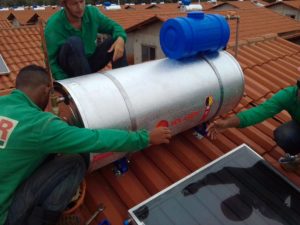India: Pilgrim Sites Use Solar Energy
May 31, 2013
India is the birthplace of three of the world’s largest religions – Hinduism, Buddhism and Sikhism – all of which admire nature and preach conservation. Some of the country’s leading religious institutions have walked the path of sustainable development. It has made India a showcase for the use of solar thermal for community cooking needs. The country has at least a dozen large religious sites which use cooking systems with solar thermal concentrators. The largest of them is at Saibaba Ashram in the town of Shirdi, Maharashtra State. Commissioned in 2009, the kitchen complex has 73 parabolic dishes to capture the sun’s rays and cook food for 50,000 devotees every day. The solar cooking saves nearly 100,000 kg of Liquefied Petroleum Gas (LPG) each year. The photo shows the steam cooking at Muni Seva Ashram in the state of Gujarat.
India’s pilgrim sites attract visitors from across the globe all year long. These sites have large community kitchens, which offer visiting devotees a variety of meals. Firewood and LPG are the most commonly used fuel sources for cooking and traditional woodstoves – so-called Chulhas – are the most widely used cooking devices. These Chulha stoves have an efficiency of only 5 to 10 %. The effects of utilising such inefficient devices are higher fuel consumption and environmental pollution.
Entrepreneur Deepak Gadhia introduced the country to solar concentrators based on parabolic dishes – a design by Austrian inventor Wolfgang Scheffler – and began manufacturing these solar cookers more than 20 years ago. Today, the equipment is manufactured to 100 % locally, creating much-needed jobs. Gadhia, who has set up the most solar cooking systems in the country, explains that “spiritual organisations look at it from a different angle. They want energy which is spiritually positive and solar energy best fits this concept.”
The solar steam cooking system is added to existing firewood or LPG steam boilers, which are still used in the evening and during prolonged periods of bad weather.
Some of the globally renowned solar installations can be found at Muni Seva Ashram and Bramha Kumaris Ashram in Gujarat state, the Art of Living School in Karnataka state, the solar bowl at the Ashram in Pondicherry and the Akshardham Temple in New Delhi. There are also many small installations of up to 10 m² in public institutions, in order to meet the needs of day-to-day cooking.
Prof Ajay Chandak, a leading consultant and trainer in parabolic dish development, argues: “Solar community cooking is ideally suited for religious institutions in India and can go a long way towards conserving energy, but the problems are the upkeep and continual maintenance of the systems.” The professor has observed that the system developers hand over the installation to the beneficiaries without having a plan to ensure proper maintenance. He mentions a case in which a 1,000 m² dish area for cooking the meals of 15,000 people stopped working because of maintenance issues.
The success of the solar community cooking depends on the post-installation work executed by properly trained personnel, as in the case of Bramha Kumaris Ashram and Muni Seva Ashram. It is up to the suppliers of solar concentrating systems to ensure proper training of the client’s staff. With more than 30,000 temples and religious places in the country, India’s solar community cooking could serve as an example to the world. In addition, Phase II of the Solar India Mission has already set a target of 50,000 new cooking systems with solar concentrators in at least 100 community kitchens and about 25,000 schools.


